![]()
![]()
![]()
Use LEFT and RIGHT arrow keys to navigate between flashcards;
Use UP and DOWN arrow keys to flip the card;
H to show hint;
A reads text to speech;
10 Cards in this Set
- Front
- Back
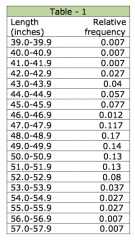
Draw a relative frequency histogram of the data. Comment on the shape of the distribution.
|
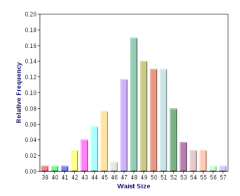
The histogram follows bell curve patterns, except for one outlier at 46-46.9.
|
|
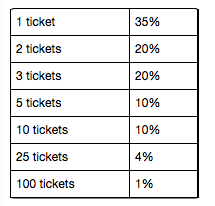
The most popular game at Fred's Fun Factory arcade is the "spinning wheel" game. A player pays a fixed amount of 25 cents to spin the wheel. When the wheel stops, the player is awarded tickets based on where the wheel stops. There is no skill component; each spin of the wheel is a random event, and the result from each spin is independent of the results of previous spins. The wheel awards tickets with the probabilities shown in the table. A. If a player were to play this game, many, many, times, what is the expected (average) number of tickets that the player would win from each spin?
|
(1*0.35)+(2*0.2)+(3*0.2)+(5*0.1)+(10*0.1)+(25*0.04)+(100*0.01)= 4.85 tickets.
|
|
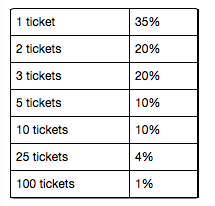
The most popular game at Fred's Fun Factory arcade is the "spinning wheel" game. A player pays a fixed amount of 25 cents to spin the wheel. When the wheel stops, the player is awarded tickets based on where the wheel stops. There is no skill component; each spin of the wheel is a random event, and the result from each spin is independent of the results of previous spins. The wheel awards tickets with the probabilities shown in the table. B. Every day over the summer, a young boy gets $5.00 in quarters from his parents and uses them all to play the spinning wheel game. What is the average number of tickets the boy can expect to win each day using this strategy?
|
$5.00 = 20 quarters 20 * 4.85 = 97 tickets each day (because the average number of tickets won on each spin is 4.85 per previous calculations)
|
|
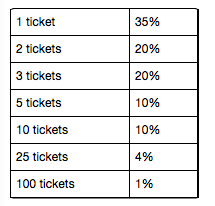
The most popular game at Fred's Fun Factory arcade is the "spinning wheel" game. A player pays a fixed amount of 25 cents to spin the wheel. When the wheel stops, the player is awarded tickets based on where the wheel stops. There is no skill component; each spin of the wheel is a random event, and the result from each spin is independent of the results of previous spins. The wheel awards tickets with the probabilities shown in the table. C. The boy who spends $5.00 every day is saving up his tickets in hopes to get an item that costs 300 tickets. It is also available down the street for $4.99. From a monetary point of view, would you advise the boy to try and win the item with tickets or go any buy it from the store? Explain.
|
Based on the expected average of 4.85 tickets for each game, it would require 62 plays to win 300 tickets. 62 *$0.25= $15.50, which is much more than buying the item at the store for $4.99, so I would recommend that the boy buy the item at the store.
|
|
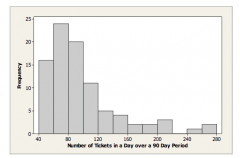
The most popular game at Fred's Fun Factory arcade is the "spinning wheel" game. A player pays a fixed amount of 25 cents to spin the wheel. When the wheel stops, the player is awarded tickets based on where the wheel stops. There is no skill component; each spin of the wheel is a random event, and the result from each spin is independent of the results of previous spins. This histogram summarizes the results of 90 summer days of a boy playing $5.00 per day on the spinning wheel game. For what percentage of the 90 days did the boy earn fewer than 100 tickets in a day?
|
60/90= 66.67%
|
|
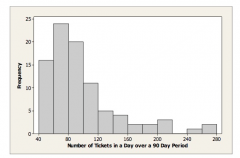
The most popular game at Fred's Fun Factory arcade is the "spinning wheel" game. A player pays a fixed amount of 25 cents to spin the wheel. When the wheel stops, the player is awarded tickets based on where the wheel stops. There is no skill component; each spin of the wheel is a random event, and the result from each spin is independent of the results of previous spins. This histogram summarizes the results of 90 summer days of a boy playing $5.00 per day on the spinning wheel game. For what percentage of the 90 days did the boy earn 200 tickets or more in one day?
|
6/90 = 6.67%
|
|
|
A friend of yours, emails you asking about a new scratch-off lottery game. It costs $10 to play. There are 2 outcomes for the game (win and lose) and the probability that the player wins a game is 60%. A win results in $15, for a net win of $15. The probability distribution for x= the amount of money a player wins (or loses) in a single game is shown. Compute the expected value of X.
|
E(X)=(5*0.60)+ (-10*0.40)= -1. This means there is an average loss of $1 per game in the long run.
|
|
|
A friend of yours, emails you asking about a new scratch-off lottery game. It costs $10 to play. There are 2 outcomes for the game (win and lose) and the probability that the player wins a game is 60%. A win results in $15, for a net win of $15. The probability distribution for x= the amount of money a player wins (or loses) in a single game is shown. Your friend wants to know if he should play this game many, many times to make some extra money because the 60% chance of winning $5 sounds really good. Based on previous calculations, would you recommend that he play the game many, many times or that he not play the game? Explain.
|
I would not recommend that my friend play the game many, many times, because he will not make money in the long run. Instead, he will lose, on average, a dollar per game. This means there is no long term gain to be made from playing this particular game many, many times.
|
|
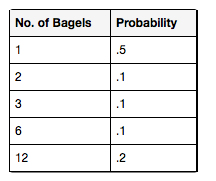
Bob's bagel shop has estimated the probabilities for the number of bagels a randomly-selected customer buys when they come into the shop (shown in table). Bob sells bagels for $0.80 each, or $9.00 for a dozen. If X=the amount of money Bob collects from a randomly-selected customer, find and interpret the expected value of X.
|
This problem is more easily solved when a probability distribution is made. Using this table, the expected value of X is, E(X)= (0.8*0.5)+(1.6*0.1)+(2.4*0.1)+(4.8*0.1)+(9.0*0.2) = 3.08. Bob can expect to make about $3.08 per customer in the long run.
|
|
|
Last month, 275 out of 350 customers bought one or more pairs of shoes when they visited the shoe store. Thus, the probability that a randomly-selected customer purchased a pair of shoes is 275/350= 0.78. Is this estimated probability or empirical probability?
|
This is empirical probability because we are given all the information needed to calculate the "actual" probability, instead of the calculations being based on a sample of the survey population.
|

